Yalda Afsah
Kunstverein München and Halle für Kunst Steiermark, Graz
by Robin Waart
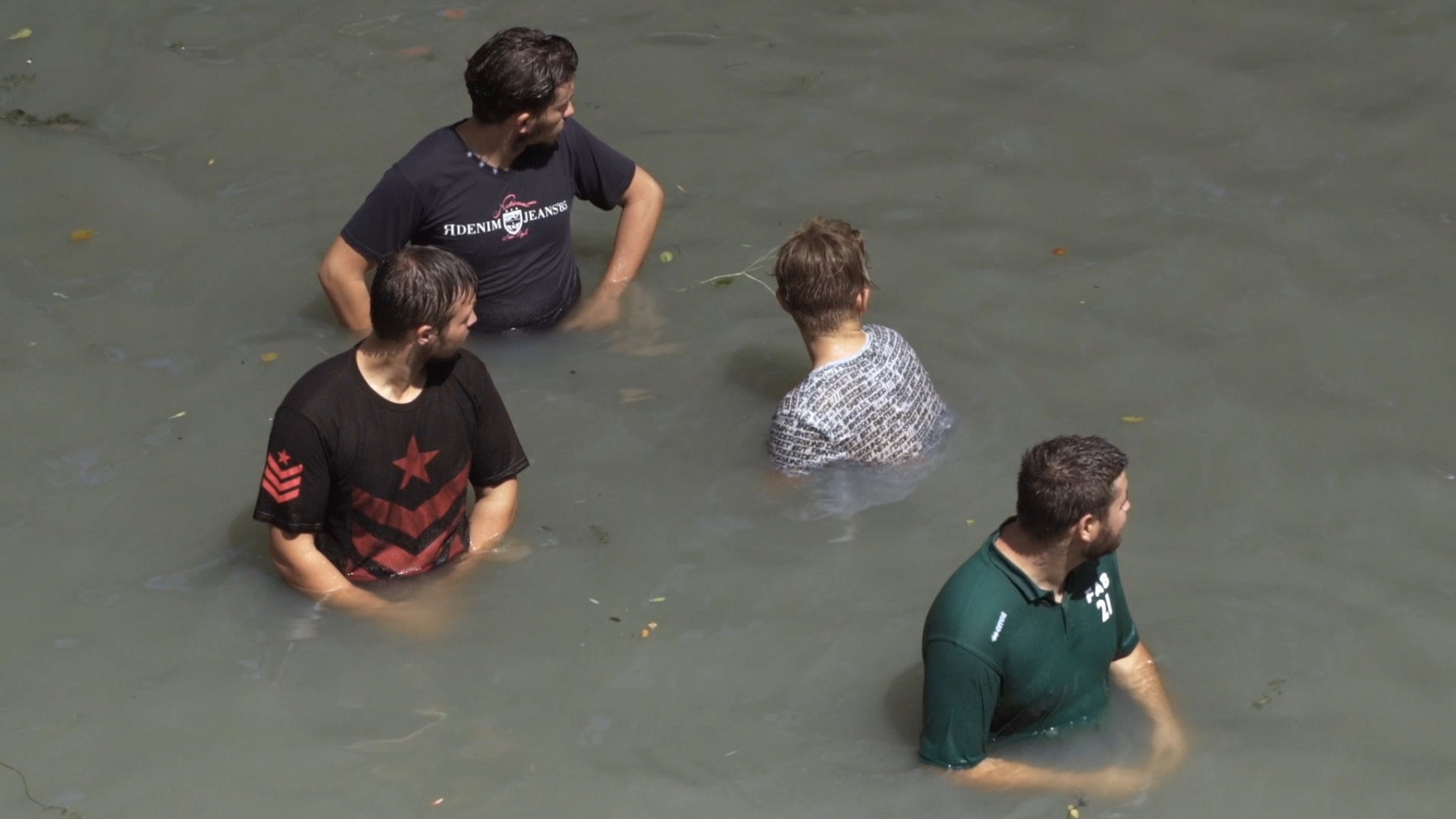
Yalda Afsah, VIDOURLE, 2019. Film still. Courtesy the artist.
"Ten more glorious days without horses!"
Iris Murdoch [1]
The animals that surround us are often present only in the traces they leave on or around us: the itching bump on an arm (a mosquito), a heap of fresh earth disturbing the lawn (moles), the dog droppings you step on occasionally (swearing!), footsteps in the snow (what animal is this?); the screech or song of birds somewhere nearby. But where exactly? Immanent or imminent, desired, detested, just not there when you (don’t) want them to be. It is distance that often marks our relationship with other creatures. A separation is based either on different needs and living conditions (in air/water, under/above ground, day/night), or because we learned to stay away from each other, for dangers of viruses, attacks or, well, the threat of extinction that in recent years has transformed the idea of what a zoo could be, from a place of caged captivity into a reproductive sanctuary.
Yalda Afsah’s four most recent films –on view at Kunstverein München this spring and now at Halle für Kunst Steiermark in Graz through the entire summer– confront the viewer with this absence or distance that marks the relationship between human and animal. The ‘thing’ [2] you do not see is different in each of them. In Vidourle (2019), named after the river in the south of France, the camera registers anything but the bullfight that is taking place. Instead, it pans and zooms in across youngsters standing in the water or the river’s banks, teasing out the animal as a missing protagonist. The scene unfolds in broad daylight, to the sound of countless crickets chirping. At nightfall, overshadowed by the buzz of an ionising drone, Tourneur (2018) is again centred around a local type of contest. Let out of a metal container at the beginning of the short film, the bull is mostly hidden in huge clouds of artificial foam. Some young men enter this arena, aiming at once to reach and to avoid the animal, while others –mixing the role of viewers and participants, engaged or lost– clap, whistle, and scream. A confused dog runs through the frame. Even when mostly unseen, the bull very much exists. As it emerges from the foamy space, you immediately see its horns are covered by a rubber ball, like coffee without caffeine.
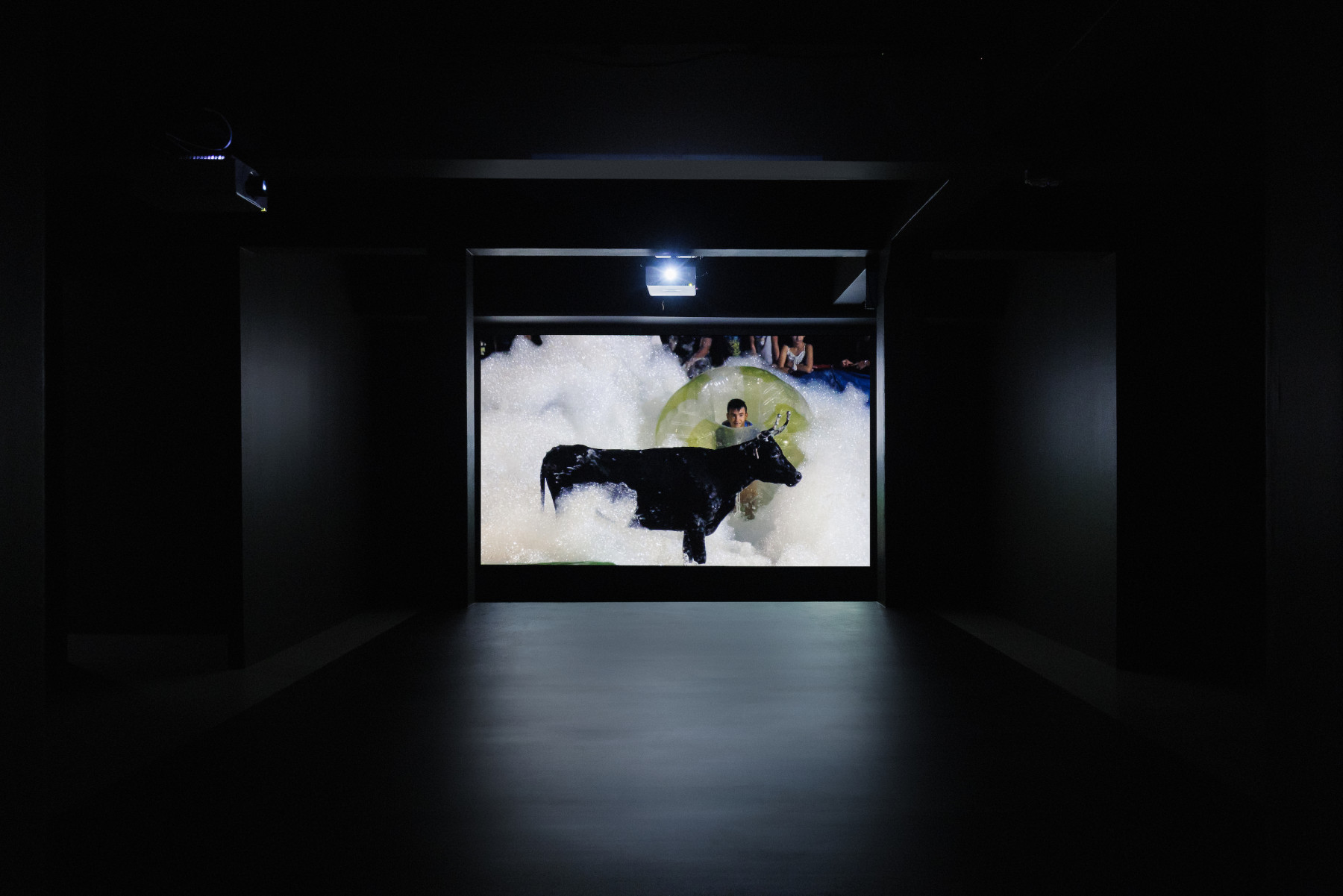
Yalda Afsah, TOURNEUR, 2018. Installation view, Every word was once an animal, 2022. HALLE FÜR KUNST Steiermark. Photography: kunst-dokumentation.com.
If what it means to be human has long been defined by a ‘plus’ (starting with Aristotle’s ζῷον λόγοϛ ἔχων ‘an animal with a mind’), being animal has always implied the opposite. Some sort of lack or missing part: no brain, no soul, no pain (a machine, Descartes). Being unable to speak, while we, on the contrary, are ‘language-animals’. [3] What the first two of Afsah’s films actually bring to the fore is the fragility in having such a plus – because of the implication: having something also means having something you can lose. The hide-and-seek within the foam in Tourneur isn’t even enough of a cover: some of the most active boys, pretending to be brave, are also clad in a protective plastic bubble. In this game, each of these props becomes a necessity to evade the bull’s eye, while the fuming and stressed bullock itself seems to need nothing. An animal cannot be naked, as Derrida has said in his ruminations in The Animal That Therefore I Am. Indeed the young bull doesn’t at all care what clothes the kids are wearing. All it wants is to be left alone. With their shirts off, seemingly embarrassed at times, what is play (even culture) to them is in no way make-believe for their opponent. [4]
In Centaur (2020) and SSRC (Secret Society Roller Club, 2022) the animal-human relationships portrayed are closer to domestication, domination. Embellified in Centaur – between an older white male trainer, whip in hand, dressing his stallion inside the rinks of an English-looking riding school adorned with painted portraits of his predecessors. And, without the power play, SSRC (Afsah’s newest film) focuses on a member of a South Los Angeles roller pigeon club and his rollers, a species of pigeons selectively bred for their natural ability to tumble or roll in the air, as if falling, picking up mid-flight again. Large parts of the movie, like Tourneur and Viderle, track the human participants, now not frontally but from behind, looking up at a clear blue sky, arms raised, at the birds performing high up in the distance.
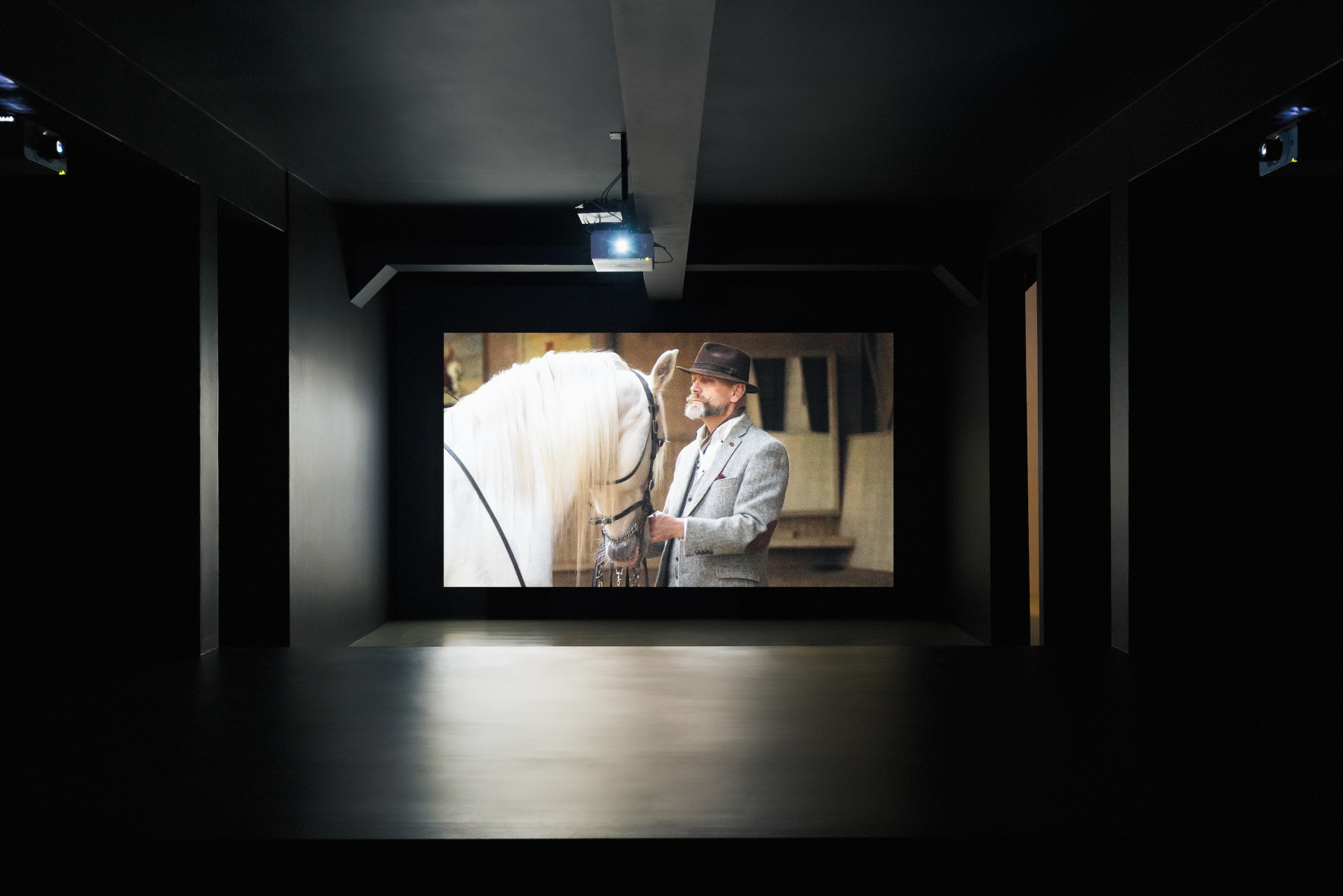
Yalda Afsah, CENTAUR, 2020. Installation view, Every word was once an animal, 2022. HALLE FÜR KUNST Steiermark. Photography: kunst-dokumentation.com.
Whereas in the bull films the restless, only partially handsome or trained bodies of the bullfighters record a youthful prowess, provincial and past-tense, the well-suited tweedy aristocrat in Centaur becomes almost appallingly out of sync. Most of my sympathy automatically veered toward the trainer in SSRC, also the only film accompanied by a voiceover, apart from the sound of wings flapping, silences and cooing. This human voice speaks about his birds, their training and having to hold them in his hands up to four or five hours a day, pointing to a ‘blood feather’ (the word used for new grown pens) on one of the wings. He wears a necklace and shirt with the club’s name on it, next to the simplified, hieroglyphic image of a ringed pigeon, itself dressed in a pigeon-sized black leather coat. He has a few grey hairs already; but his beard does not look old for someone patiently telling the camera he is 38 today, as if counting how many pigeon’s years that is.
The roller pigeons that the man named Dallas competes with are not ‘feigning’ to fall. They are really ‘tumbling’, as Afsah follows their flight through the blue LA sky and the simple wooden hut where they rooster and feed, exiting freely, in between intensive training. What makes SSRC so palatable and exemplary for other possible ways of interacting with animals is the reversal of roles that does not happen in the other three films. Admittedly, things are still unequal, but when he spreads the bird’s wings in between his fingers, folds them back, playing with them, but also for comfort, his touch is soft, kindness replaces pressure: proposing it is the dove that is forcing him to listen, to be careful, and not the other way round.
Similarly, if the tumbling is something of a natural movement coaxed out by selection and training – what is presented in SSRC is an act entirely different from the lively production of aggression in Vidourle, Tourneur, even if in Centaur it is “but” the alarming swoosh of a whip in the air, made to keep the steed alert. One could say the horse is not part of the human fiction whose lead it’s playing, no part of the drama in the painted models in the stable it is surrounded by. Even if his rider does not use words, however lovingly he looks at the disinterested horse, as if to identify with it, as Centaur, half-man, half-horse, suggests, something in this identification is only half-willed. What struck me was the difference, that only one of them has a choice. The horse couldn’t even step out of its ‘role’ if it wanted to, but why wouldn’t he? It is a question that applies to humans alone: A duck hatched in the wrong nest might believe it is a swan and a sheep (as it happens) can imagine they are a dog, but they aren’t fooling anyone. The animal, as Valéry explains, is “undivided.” [5]
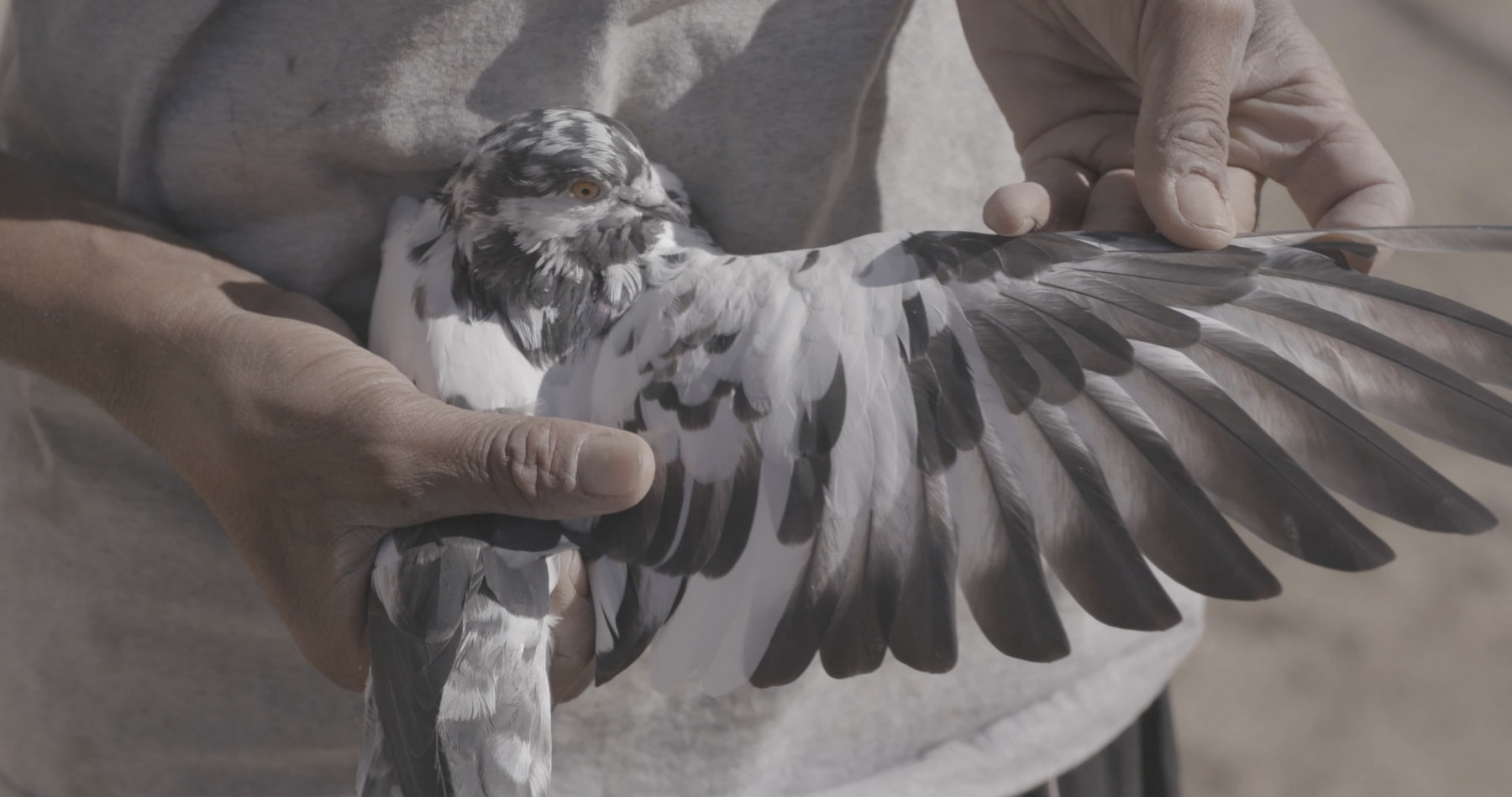
Yalda Afsah, SSRC, 2022. Film Still. Courtesy the artist.
While the two shows in Munich and Graz present the same four films, their display is stunningly different. From horse to bird to boys in the first instalment, on screens and scaffolding made to fit the kunstverein’s scale, high ceilings, elongated room, a huge central bench in the main room and individual ones for the others. Their sounds blended together, infusing, influencing each other, running on loops not entirely synchronised: the nervous hooves of Centaur mixing with the bassy, woofing electronic sound of Tourneur, sometimes blazing through the pigeon’s cuckoo, the crickets chirping, daylight and noise seeped into the building. In Munich, an appendix of articles on the tumbler bird society and historical materials relating to the kunstverein’s history with animals was presented in its archive space, more like a supplement. In Graz, the show is staged underground, in the dark, and, inversely, introduced by book covers and photos pertaining to SSRC. Each of the films is played one after the other, on four walls with different-sized screens and benches to sit in the middle of the room.
There is a moment in the looped version of Centaur at the Kunstverein München when everything stops. The film has already ended, but the birds in the stable do not stop twittering. When the movie’s end credits start rolling their song continues into the following round of viewing. This decisive continuation combined with the absence of image, made it unavoidable for me to start doubting where the sound was coming from: did the song actually begin in the gardens that surround the kunstverein? Was it or was it not ‘part’ of Afsah’s film?
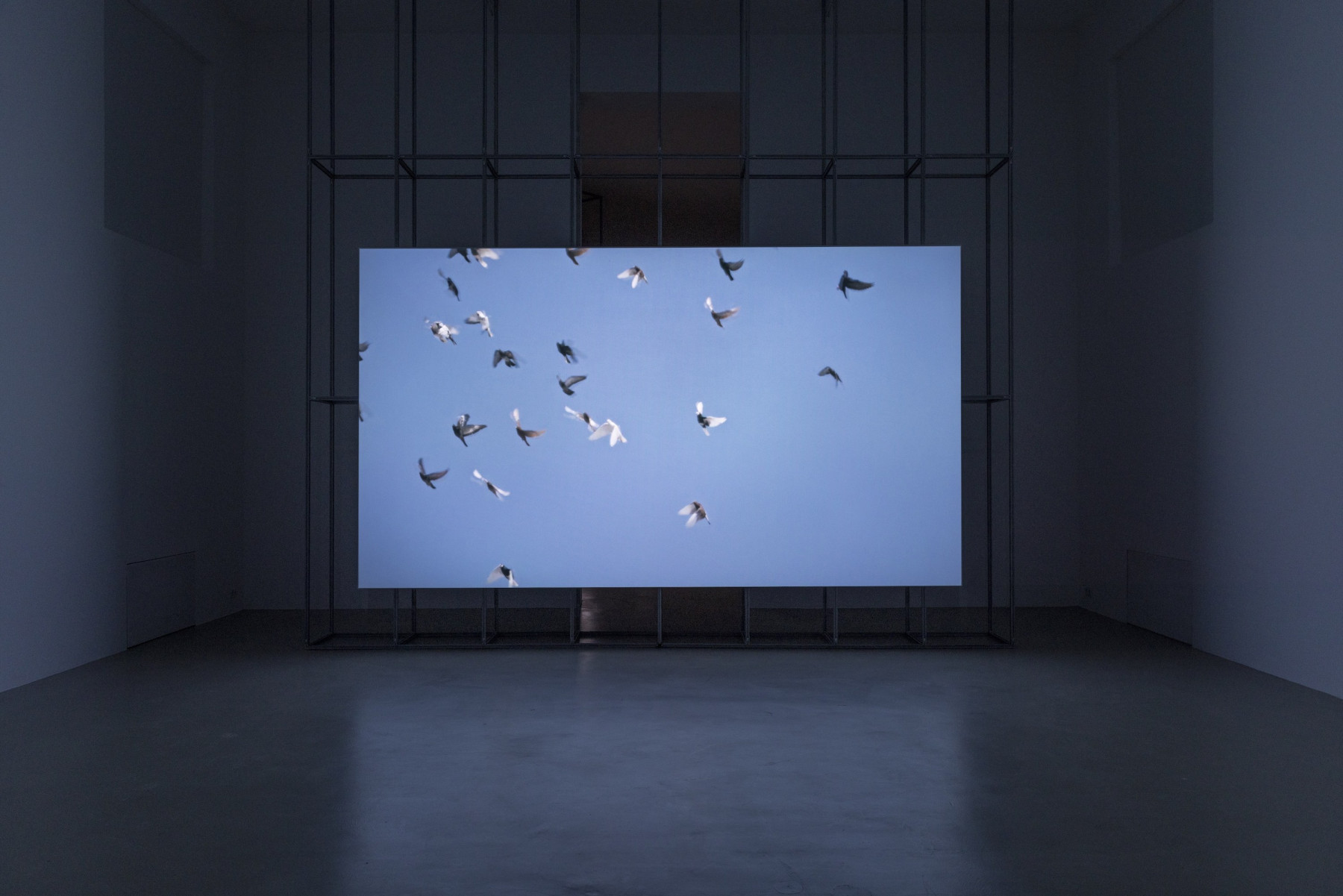
Yalda Afsah, SSRC, 2022. Instellation View, Every word was once an animal, 2022. Courtesy the artist and Kunstverein München e.V. Photogarphy: Eike Walkenhorst.
The exhibition’s title is something of an enigma. It feels nearly natural, correct, to place the origin of words in the natural world, and Every word was once an animal had been used before for other shows, a theatre play, as google will tell you. Of course it’s not really a riddle we are confronted with, but a proposal, whose grammar or lack of logic is meant to stir, to stick, a message that has been in the air awhile now, as many of us veer away from anthropocentric models of being. Another way to look at it is through the lense of written language, writing as drawing, a time when words, like hieroglyphs, were once very much linked to the world around them –a bull (א, aleph), a snake (a sound like s for instance), a bird– metonymically tied to the world we exist in. Set in the past tense, was, and situated far away, once, the title emphasises the irretrievability of this ‘sympoetic’ reality that no longer exists, but also its continuing, mythical influence. Is the language that grew from the world now standing between us?
What becomes painfully clear in each of the four situations in Yalda Afsah’s film constellation is that we cannot become silent animals again. They might need us to speak for them.
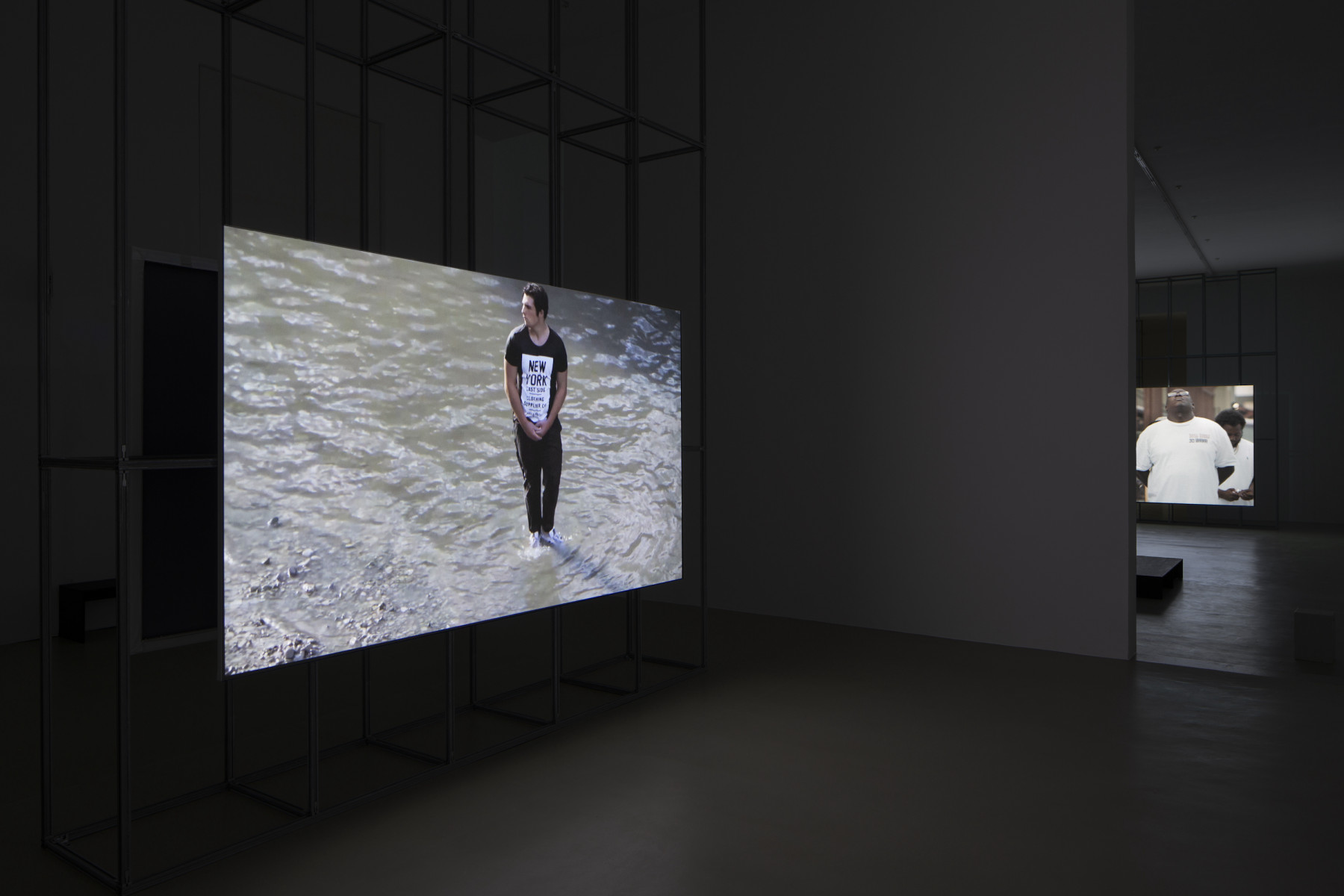
Yalda Afsah, VIDOURLE, 2019, and SSRC, 2022. Installation view, Every word was once an animal, 2022. Courtesy the artist and Kunstverein München e.V. Photographty: Constanza Meléndez.
Every word was once an animal
Yalda Afsah
24/6 – 4/9/2022
Halle für Kunst Steiermark
Burgring 2,
8010 Graz
15/01 - 10/04/2022
Kunstverein München
Galeriestraße 4,
80539 München
[1] Opening line of Iris Murdoch’s The Red and the Green (1965), also quoted by John Searle in ‘The Logical Status of Fictional Discourse’, New Literary History, Vol. 6, No. 2, 1975.
[2] “for pets are indeed an intermediate category between human beings and objects. (...) The object is in fact the finest of domestic animals – the only ‘being’ whose qualities exalt rather than limit my person.”, Jean Baudrillard (trans. James Benedict), ‘II A Marginal System: Collecting’, in The System of Objects. Verso, London/New York 1996 (1968 1st), p. 95.
[3] Tine Melzer, Taxidermy for Language-Animals. A book on stuffed words. Rollo Press, Zürich 2016.
4 “Why can’t a dog simulate pain? Is it too honest? Could one teach a dog to simulate pain? Perhaps it is possible to teach it to howl on particular occasions as if it were in pain, even when it isn’t. But the right surroundings for this behaviour to be real simulation would still be missing.”, Wittgenstein, Philosophical Investigations / Philosophische Untersuchungen, 250 (Translation G. E. M. Anscombe, P. M. S. Hacker and Joachim Schulte. Revised fourth edition. Wiley-Blackwell, Chichester 2009).
[5] Paul Valéry, ‘Animalities’, in Collected Works of Paul Valéry, Volume 2. Poems in the Rough (trans Hillary Corke). Bollingen Series XLV 2. Princeton Legacy Library, Princeton University Press, Princeton N.J. 1969, p. 80.